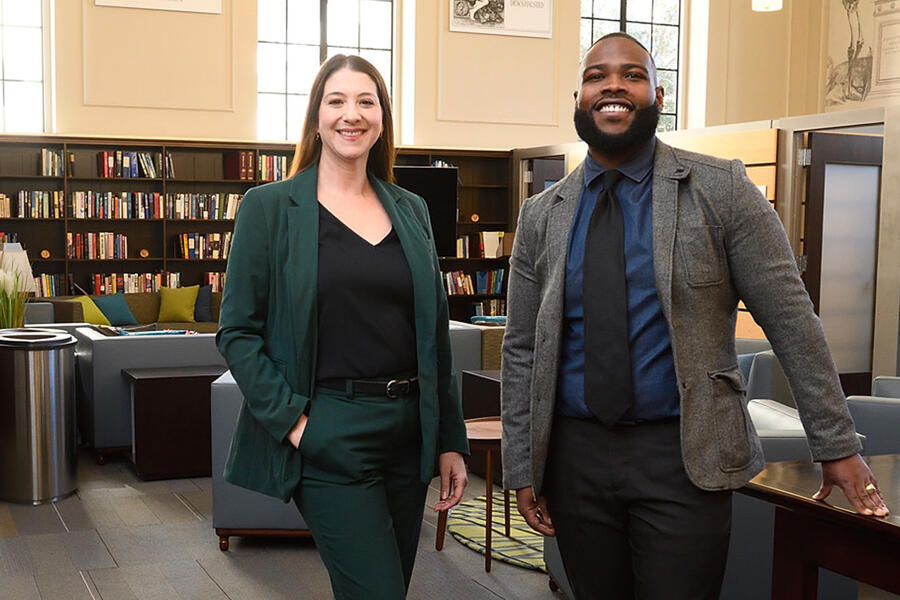Historian Franklin Knight, who retired in 2014 from the faculty of the Krieger School of Arts and Sciences after 41 years, appreciates a fine aged and blended dark rum. He not only loves to sip it but also gives talks about it, and he's currently immersed in another rum-infused project: writing a book about it. Knight, who taught comparative world history and history of Latin America and the Caribbean, is thrilled at the prospect of further sharing his knowledge of rum's colorful past.
"Rum is the most pleasurable distilled alcoholic beverage in the history of the world," he says, attributing his Jamaican origins as his early source of inspiration. "In one way or another, rum comprised an essential part of all festivities in Jamaica and elsewhere throughout the Caribbean region."
He credits—with enthusiasm—his post-retirement literary endeavor to the influence of the Academy at Johns Hopkins, a university initiative created to encourage faculty retirees to continue their research, writing, and other academic pursuits; exchange their expertise and insights with one another; contribute to the community; and stay connected to the university.
Jennifer Van Beek, of the Office of the Vice Provost for Faculty Affairs, is the Academy's manager. "JHU leadership recognizes that faculty contributions don't end when they step down from full-time work," she says. "Leadership truly values our retired faculty and the incredible impact they've had throughout their careers—and continue to have long after they've retired. Retired faculty form a unique brain trust of some of the most accomplished individuals in their fields, and they continue to make a significant impact—not only at Hopkins but in local, national, and international communities through volunteering and service. We want to make retirement feel less like an end and more like a new chapter."
This commitment was demonstrated by the university's decision to move oversight of the Academy to the Provost's Office rather than have it managed by individual schools, a shift that reflects leadership's dedication to supporting senior faculty "at every stage of their journey, from full-time careers to retirement, and ensuring resources are accessible universitywide," she says.
"Most faculty are reluctant to retire because they are passionate about their work, so this was an opportunity to offer something of an enriching nature to make retirement more attractive and to provide them an avenue to maintain their academic and research missions," she adds. "It's a way of staying in touch with your academic colleagues in retirement and meeting new ones from different disciplines you may not have had the opportunity to meet and work with during your career."
The Academy was founded in 2012 at Homewood for retired Krieger faculty and later expanded to include retirees from the Whiting School of Engineering, School of Education, Peabody Institute, Carey Business School, and SAIS. Most of the schools offer annual stipends of several thousand dollars to each of its Academy members to offset their academic expenses.
In 2018, the Academy opened a second site, in East Baltimore, for faculty retirees from the schools of Medicine, Nursing, and Public Health.
The Homewood Academy is located temporarily in the former Johns Hopkins Club and will return to its home in the Milton S. Eisenhower Library when the renovation of that building is completed. The Academy in East Baltimore is in Welch Library. Each Academy suite features a boardroom fully equipped with audiovisual technology along with office and lounge/meeting space. The academies use these suites for their regular meetings and events, and members can hold meetings there, or simply find a quiet space to work. Each location has lockers so that members can store items.
Homewood currently has 44 members and East Baltimore, 163. Any retired faculty member can join—there are no specific criteria, just a simple application with their dean's approval. Senior faculty who are still working but transitioning to retirement also are welcome to join before their official retirement date.
Kofi O. Anning is the Academy's senior academic program coordinator. After working at pharmaceutical and biotechnology companies in Illinois, he joined JHU in 2022 as a project coordinator in the Department of Otolaryngology in the School of Medicine. In 2024, he moved to the Provost's Office.
His role at the Academy is diverse, supporting members at both locations, helping them with their ongoing projects and providing whatever administrative and IT support they may need "to bring their initiatives to life," he says.
"The Academy is a place for them to go to when they are thinking about retirement," Anning says. "It gives them the opportunity to continue to be included in academic community initiatives after having retired from full-time employment. They have so much energy and so much to give."
Van Beek joined JHU in 2018 after working as a federal contractor for the U.S. Department of Agriculture in auditing and accounting. "While I appreciated the experience [in that position], I was seeking a role that would offer more opportunities to engage with people and create impactful programs," she says.
Initially, she helped design programming aimed at senior faculty on the East Baltimore campus, then participated in the Academy's opening there. She also helped build the School of Medicine's Senior Faculty Transition program, which provides pathways for faculty approaching retirement while retaining full-time benefits, and she advised the schools of Nursing and Public Health in creating their own transition programs. She moved to the Provost's Office in 2021 to support faculty across campuses.
"One of my proudest achievements has been the expansion of the Homewood Academy, which previously served only retired faculty from the Krieger School," she says. "I've been able to grow the Academy to include faculty from additional schools. In my role, I am able to advance the goals of enhancing resources for senior faculty universitywide and fostering a vibrant, collaborative community of retired faculty. I'm truly passionate about my work, and I feel incredibly fortunate to be in a role that allows me to support faculty and create programs that have such a meaningful impact on their lives."
Van Beek points out that each academy has its own flavor. "Homewood's is more academic, with weekly lectures, discussions, and ongoing projects, while East Baltimore is more focused on service to Hopkins and community because it has a lot of clinicians and doctors trying to find a way to use their expertise in retirement."
For example, she says, retired Hopkins physicians in East Baltimore participate in the Maven Project, an organization that draws upon clinicians who are no longer practicing "and has them consult with community physicians around the country on difficult cases, or on those that require a special expertise," she says. "In retirement, they have more time to do this kind of work and share their clinical expertise."
East Baltimore Academy members also volunteer locally. Genetic counselor Virginia "Ginny" Corson, for example, has become passionate about volunteering in food drives and harvesting events, and at a local public elementary school. She first became involved after retiring in 2018 from the School of Medicine and JHH, where she spent 43 years seeing patients.
With fellow Academy member Dorothy "Dotty" Rosenthal, professor emerita of pathology and cytopathology at the School of Medicine, she co-chaired a committee that created a roster of potential community volunteer activities for Academy members. These include stocking food for patients' families at the pantry at the pediatric Harriet Lane Clinic and harvesting produce at First Fruits Farm, which donates food to more than 300 organizations, including the Maryland Food Bank and the Central Pennsylvania Food Bank, along with churches, pantries, shelters, schools, and other nonprofits serving low-income families and individuals throughout the mid-Atlantic region.
"We've gone [to First Fruits Farm] once a month in the summer for several years now," Corson says. "It's fantastic. We work for a couple of hours in fields or in the greenhouse, and then we go out to have a fun lunch together."
The East Baltimore Academy also has developed a relationship with Henderson-Hopkins, the Johns Hopkins partnership school located nearby. During the pandemic, the Academy raised money for a school food drive and helped staff the school-based COVID vaccination program for the community.
Under Rosenthal's leadership, members also are working with the Baltimore Symphony Orchestra's Orchkids program to find musical instruments to donate to its Baltimore City partner schools, Corson says. Orchkids programs provide free music instruction, instruments, academic assistance, meals, mental health resources, connection to social services, and performance and mentorship opportunities to students and their families.
For Corson, "it's been really worthwhile to work with other Hopkins folks on giving back to the community. These opportunities have really developed because of the Academy. It's very meaningful doing it with other members rather than doing it on my own."
One major goal of the Academy, Anning says, is "to expand the reach of Hopkins and all Hopkins professors, including the retired, because we think that Hopkins is great resource with enormous value."
At the Homewood site, numerous members have been working on their own innovative academic and research-oriented projects, Anning says.
Many members, like Knight, are turning their expertise into literary endeavors, writing a series of pocket-size books. Funded by the Krieger School, they will be known as Capstone books and bear the imprimatur of the Academy. These include Knight's book, A Guide to the History and Connoisseurship of Rum, and What's So Funny? A Short History of Laughter, by Stephen Nichols, the James M. Beall Professor of French and Humanities and an expert on the Middle Ages who co-directs the Johns Hopkins Digital Library of Medieval Manuscripts. Geologist Bruce Marsh, professor emeritus of Earth and planetary sciences, is writing Geothermal Energy: A Guide.
"They will be pocket-size and in lay terms so anyone can pick them up and read them," Van Beek says. "It's important to have the Academy organization behind it. They will have an emblem that would identify it as a product of the Academy at Johns Hopkins."
Other members are engaged in mentoring junior faculty, giving "the retirees the opportunity to provide rising educators with the benefit of their experiences," Van Beek says.
Homewood Academy members meet every Wednesday for lunch to exchange ideas and opinions and to hold an informal book club. They also sponsor guest lectures. "We bring in all kinds of speakers, including specialists and scientists from outside Hopkins," Van Beek says. Recent lecturers included Massimo Roberto of the Space Telescope Science Institute, speaking about the James Webb Space Telescope, and Charles Duff, author of The North American Cities. JHU President Ron Daniels and Provost Ray Jayawardhana also have visited, updating retirees on university plans and challenges.
Knight says that his Academy experience is stimulating. "I not only find my colleagues highly informed about their own specialties, but they also have a great intellectual curiosity about others' interests, able to talk about history, for example, when they are specialists in quarks.
"When we meet, there are no academic boundaries," he adds. "We think through things together. We have formed an admirable intellectual community, which I enjoy a lot. The Academy has allowed me to be active intellectually in my field, and it provides the most interesting experience in continuing education that I know."
Posted in News+Info
Tagged who does that?









